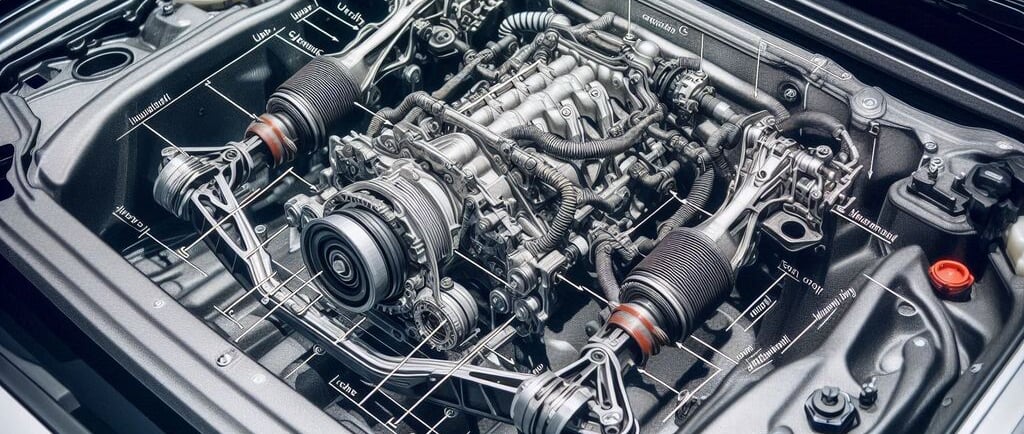Upper and Lower Mounts
When it comes to vehicle suspension, upper and lower mounts play a crucial role in maintaining stability, comfort, and performance.
SUSPENSION PARTS
11/14/20244 min read


Understanding Upper and Lower Mounts in Vehicle Suspension: What You Need to Know
When it comes to vehicle suspension, upper and lower mounts play a crucial role in maintaining stability, comfort, and performance. Whether you're driving on smooth highways or rough terrain, these mounts help your car absorb shocks, maintain control, and ensure a smooth ride. But what exactly are upper and lower mounts, and how do they contribute to your vehicle’s overall handling and comfort?
In this guide, we’ll break down the purpose of upper and lower mounts, their differences, and when you might need to inspect or replace them for a better driving experience.
What Are Upper and Lower Mounts?
The Basics of Suspension Mounts
In vehicle suspension systems, mounts serve as the attachment points between various suspension components and the vehicle frame. Upper and lower mounts specifically secure components like shocks, struts, and control arms, helping the vehicle absorb impact and maintain stability. These mounts are typically made of rubber or other durable materials that absorb vibrations and support the suspension's flexibility.
Upper Mounts are located at the top of suspension components, often connecting the struts or shocks to the vehicle’s frame. They play a key role in absorbing vibrations from the road and stabilizing the suspension system.
Lower Mounts are found at the bottom and are often associated with the control arms or lower part of the shocks. They help in maintaining the vehicle’s alignment and balance while providing additional support to the suspension components.
Why Are Upper and Lower Mounts Important?
Impact on Ride Comfort
Upper and lower mounts play a significant role in enhancing ride comfort. They reduce the transfer of road vibrations and bumps to the cabin, ensuring a smoother, more comfortable ride for both the driver and passengers. Well-functioning mounts absorb road irregularities and keep vibrations from reaching the vehicle frame, creating a quieter driving experience.
Contribution to Vehicle Handling and Stability
Mounts are also crucial for vehicle handling and stability. They support the suspension components to help the vehicle respond better to turns, stops, and other maneuvers. Worn mounts can cause excess movement in the suspension system, which impacts steering and handling precision, making it harder to control the vehicle, especially at higher speeds or on uneven surfaces.
Example: Imagine driving on a bumpy road. With quality upper and lower mounts in place, most of those shocks would be absorbed, allowing you to maintain better control and reducing wear on other suspension parts.
Signs of Worn or Damaged Upper and Lower Mounts
Over time, even the most durable mounts can wear out due to constant use, exposure to road conditions, and environmental factors. Here are some signs it might be time to inspect or replace them:
Vibration and Noise: If you notice unusual vibrations, clunking, or squeaking noises, especially when driving over bumps, it could indicate that the mounts are wearing down.
Poor Handling: Difficulty steering, increased body roll, or a loose feel while driving can suggest worn mounts. This is often a sign that the mounts are no longer providing adequate support to the suspension.
Uneven Tire Wear: Worn mounts can lead to misalignment, causing uneven wear on your tires. This may also affect fuel efficiency and make your ride bumpier.
If you’re experiencing any of these issues, it may be time to have a professional inspect the mounts and assess the overall condition of your suspension system.
Upper vs. Lower Mounts: Key Differences
1. Position and Function
Upper Mounts: Located at the top, these mounts connect the shocks or struts to the vehicle frame. They mainly serve to reduce noise and vibrations and play a key role in steering control.
Lower Mounts: These are typically attached to control arms or the base of the shock absorbers. They help maintain balance and alignment, stabilizing the suspension during various driving conditions.
2. Wear Patterns and Durability
Upper Mounts: Tend to wear out faster as they absorb most of the road impact, especially on rough or uneven terrain. Since they’re also involved in steering, they may show signs of wear earlier.
Lower Mounts: These mounts usually last longer, but they can still degrade over time, especially if exposed to moisture, dirt, or frequent impact from rough driving conditions.
Maintaining and Replacing Suspension Mounts: Best Practices
When to Inspect and Replace Mounts
Ideally, upper and lower mounts should be inspected as part of your regular vehicle maintenance schedule. Here are some scenarios where you may want to check them:
Routine Suspension Checks: When getting other suspension components like shocks or struts inspected or replaced, it’s a good idea to have the mounts checked as well.
After an Accident: If your vehicle has been in an accident or experienced significant impact, inspect the mounts for potential damage, as even a slight misalignment can affect handling.
When Replacing Tires: If you’re noticing uneven tire wear, it may not just be an alignment issue—it could be worn mounts that are causing the misalignment.
How to Extend the Life of Your Suspension Mounts
Taking good care of your suspension system can help prolong the life of your mounts. Here are a few tips:
Avoid Rough Terrain: Driving on smoother surfaces when possible can reduce wear and tear.
Regular Inspections: Keeping an eye on suspension components during routine maintenance can prevent problems before they start.
Clean and Protect: If you live in a place with harsh winters or rough roads, washing your undercarriage occasionally can prevent salt and grime from degrading the mounts.
Final Thoughts: Why Upper and Lower Mounts Matter
Upper and lower mounts may seem like small parts, but they are essential for suspension stability, ride comfort, and handling precision. By supporting suspension components and absorbing shocks, they make every drive smoother and more controlled.



